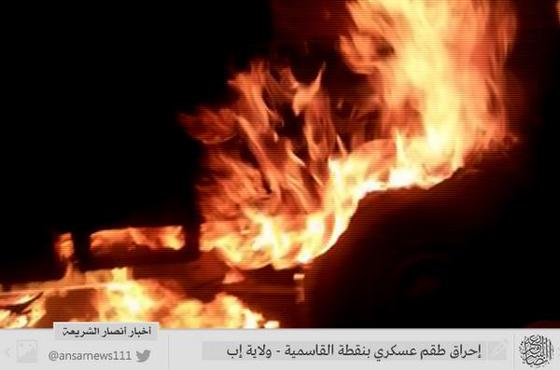 AQAP fighters set fire to a military vehicle at the Qasimiya checkpoint in al Adayn directorate, Ibb province, Yemen (Source: Twitter)
AQAP fighters set fire to a military vehicle at the Qasimiya checkpoint in al Adayn directorate, Ibb province, Yemen (Source: Twitter)
As the Houthi rebels continue their military advance throughout much of northern and central Yemen without any indication of resistance from the Yemeni authorities, al Qaeda in the Arabian Peninsula (AQAP) has increasingly clashed with the Shi’ite rebels that it deems “apostates.”
A day following their seizure of the port city of Hodeidah and the central Yemeni city of Dhamar, on Oct. 15 Houthi rebels attempted to expand the area under their control further east to the city of Radaa in Bayda province, the site of increased AQAP activity in recent months. As the Houthis began taking control of the areas surrounding Radaa, clashes broke out between the rebels and AQAP fighters, killing at least 10 people. The Houthis already have a growing presence in Bayda province, but their advance on Radaa, in western Bayda, seemed to be halted by the AQAP defensive.
AQAP also claimed credit for the assassination of a Houthi colonel in Sana’a on Oct. 15. In a statement released the same day, AQAP said that its fighters targeted Colonel Ali Zayd al Dhari with no less than 13 bullets in the Sa’awan district of Sana’a during the afternoon hours. The AQAP statement clarified that in addition his military role, al Dhari was a prominent Houthi leader.
Earlier in the day, Houthi fighters were seen amassing further west in the city of Ibb, about 150 kilometers south of the capital Sana’a. Reports claimed that the city’s governor and his aides received the Houthi rebels, yet another indication that the Yemeni government is incapable of slowing the Houthi advance. Following an agreement with the governor, the Houthis began consolidating their power by setting up checkpoints in the city on Oct. 15 and were seen in large numbers throughout Ibb. Later in the day, Houthi fighters were seen on the outskirts of the city of Taiz, even further south than Ibb, apparently preparing for a further military expansion.
However, the next day reports emerged of an agreement reached between the Houthis and the Security Council in Yemen temporarily delaying the rebel advance on Taiz city. Despite this agreement holding off the Houthi’s southern expansion, the rebels continued to expand their territory in the north. Authorities in Hajjah province bordering Saudi Arabia met with a Houthi delegation and agreed to hand over the entire province to its fighters. Subsequently, Houthis increased their presence throughout the province and even began manning the Harad border crossing with Saudi Arabia.
The Houthis’ arrival in Ibb brings the Houthi advance extremely close to Yemen’s southern provinces which have long served as AQAP strongholds in the country. In response to the Houthi’s seizure of Ibb, AQAP launched an offensive in the al Adayan directorate in southwestern Ibb province during the night of Oct. 15. According to an AQAP statement, the jihadists carried out coordinated attacks on security, military, and governmental centers in the al Adayn region and reports indicated that AQAP fighters managed to seize control of the area temporarily.
On Oct. 16, AQAP released another statement claiming that its fighters had withdrawn from the al Adayn directorate after holding the city for about 9 hours. The statement clarified that the intention of the attack on al Adayn was to “foil the Houthi plan to control it.” AQAP claimed that the attack was launched after the terrorist group received confirmed reports that local authorities were planning to hand over the city to the Houthis, as had occurred earlier in the day in the city of Ibb.
During the operation, jihadists stormed the city from four directions and carried out various attacks on targets throughout al Adayn. AQAP claims its fighters attacked the security directorate in the city, killing 3 soldiers and wounding others, including the security director, Abdallah al Halimi, and his son. The AQAP statement also mentions that fighters launched an attack on the al Qasimiya checkpoint and succeeded in seizing various weapons, including anti-aircraft missiles, after soldiers fled the scene.
The Houthi military campaign in Yemen and AQAP’s response have gained momentum following the rebels’ sweep of Sana’a on Sept. 22. A day later, AQAP declared an open war against the Houthis and called on fellow Sunnis to take up arms. These latest developments point to the possibility of increased clashes between AQAP and the Houthis and add to the growing concerns of the possibility of an all out sectarian war between Shi’ites and Sunnis in Yemen.








1 Comment
This is the all out sectarian war. This is just another front. Where next? Lebanon is shaping up quite nicely too.